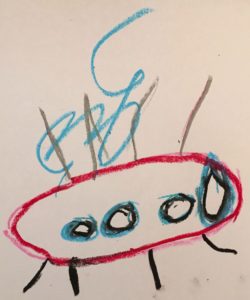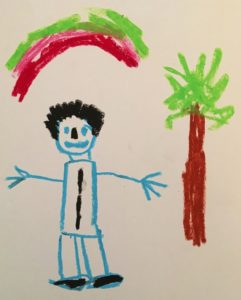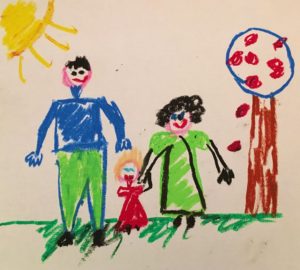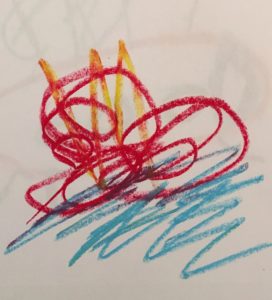Do you ever wonder what your children’s drawings are saying? Would you like to know how your kids feel? Our children have so many behaviors – loving, anxious, curious, sad, lonely, active, fearful. Looking at their pictures is one way of learning how they feel. Of actually ‘seeing’ what is in their hearts.
There is a saying that every art therapist knows: “Put a crayon in her hand and her mouth opens”. And it works. For several reasons. When drawing, our defenses are bypassed. And when we put our feelings on paper or in clay, they can be safely looked at from a distance. Acceptance of your child’s work is the first thing you can do to help him have freedom of expression
The story a child’s drawing tells may indicate your child’s developmental stage. It can also hint at some emotional problems. For example, a picture drawn by a 6 year old of a smiling girl, holding a smiling balloon, under a smiling sun, among happy flowers may just be a picture by a happy child. It may, however, indicate a yearning for happiness, a protest against inner anxious feelings.
The book MOMMY, DADDY, LOOK WHAT I’M SAYING: What Children are Telling You Through Their Art, by Dr. Myra Levick, helps us decode our children’s drawings. A qualified art therapist knows that a single drawing cannot tell the whole “picture” (pun accidental). But, a series of drawings may let us into their world.
Dr. Levick both describes the following developmental stages of children’s drawings, and also gives us some warning signs to look for:
BABBLE-SCRIBBLE STAGE/SEQUENCE: 18 – 30 months. Children should be given to freedom to explore, make large movements.
 WORD-SHAPE STAGE/SEQUENCE: 2 ½ – 3 years – Organizing shapes, rolling clay and making clay patties. Warning signs – lack of organization
WORD-SHAPE STAGE/SEQUENCE: 2 ½ – 3 years – Organizing shapes, rolling clay and making clay patties. Warning signs – lack of organization
SENTENCE-PICTURE STAGE/SEQUENCE: 4 – 7 years. Pictures with more than one object. Warning signs: things omitted, certain items scribbled. 5 years – figures a little more realistic. Stories can be told. Warning signs– floating images
6 -7 years – more realistic colors. Warning signs – parts omitted, floating, stories of danger.
FACT-FANTASY STATE/SEQUENCE: 7 – 11 years. Figures recognizable as boy or girl. Size and organization. Focus on 3 objects (representing mother/father/child triad). 
Age 9 -11 -figures more realistic, facing front and/or in profile. Warning signs – some areas regressed, or drawn darkly, omitted. Inconsistent ability in expression and skill. Unrealistic proportions.
Everything we create is a reflection of some part of ourselves. By drawing people and things, our children can master feelings and thoughts. Children’s art can reflect how they are adapting to their circumstances, or the difficulties they are having. Again, it takes more than one drawing to be able to make a conclusion.
WHEN SHOULD YOU REFER YOUR CHILD TO AN ART THERAPIST?
Is there something about the drawings that disturbs you?
Do the warnings signs crop up frequently?
Is your child suffering from emotional stress?
Does he prefer to express himself through art making and creative play?
ART THERAPISTS are trained not only in what art materials may be appropriate, but also how to ‘see’ the pictures your child makes, and how to talk about them with the child.
SOME ART ACTIVITIES KIDS CAN DO AT HOME
- Draw a picture of your family.
- Tear and paste magazine pictures on colored paper.
- Make up an imaginary animal and a story
- Build something with craft sticks or toilet paper rolls
- Make believe food out of play dough and make up a story
- Sponge painting
- Scrapbooking
- Paper bag puppets
- Paper plate masks
ART SUPPLIES TO HAVE ON HAND: tempera or water color paint, wax crayons, oil pastels, sponges, newspaper, colored paper, large drawing paper, computer paper, pencils, different size brushes, washi tape, glue sticks, shoe boxes. You may even like Myra Levick’s book, Mommy, Daddy, Look What I’m Saying: What Children Are Telling You Through Their Art.
HAVE FUN! Allow the mess. Children’s drawings express their feelings. Baby Wipes clean up almost everything!
If you have concerns, please call me at 720-242-9241 for a consult or to make an appointment.







